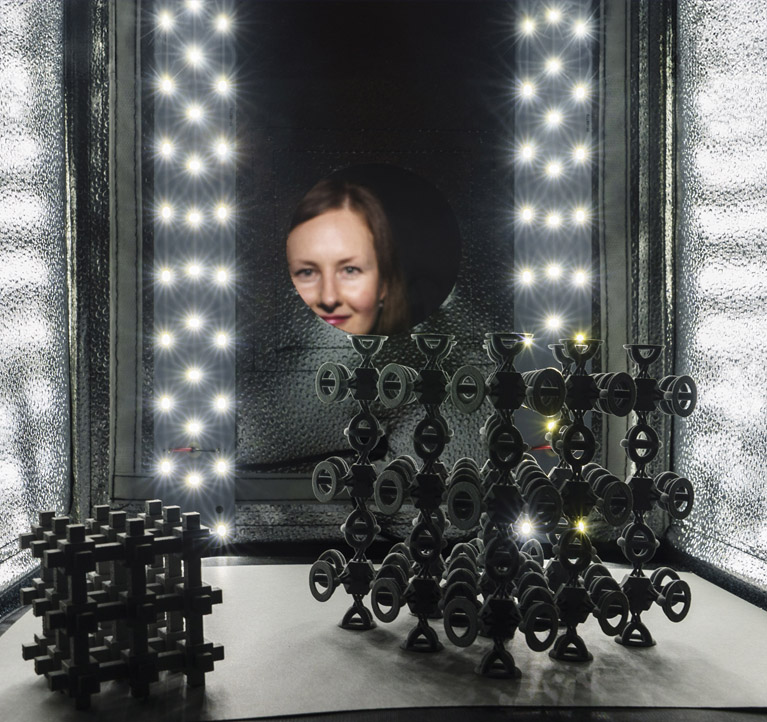
ThebreakthroughAnastasiia Krushynska
Getting the green light for an implant
She was this close to giving up. Anastasiia Krushynska has been studying metamaterials for years. These materials are composites that have the exact same mechanical characteristics on both a small scale and a large scale. In her lab, the applied physicist refined synthesis techniques and mathematical models and performed small-scale tests.
‘Metamaterials are essentially composites made out of base material and air’, she explains. The base material can be anything, such as rubber or plastic. ‘By cleverly and precisely creating pores in the material, you can adjust its characteristics.’
For instance, she can use triangular pores to create materials that transform turning forces into pulling forces and vice versa. Other metamaterials can be used as sound barriers along busy roads because they absorb sounds, or in athletic shoes. ‘The possibilities are endless’, says Krushynska. ‘They work, but I wanted to see them in action.’
Jawbone
But that turned out to be fairly difficult. Krushynska first attempted to get the business world interested, but it wasn’t going well. ‘Metamaterials are still pretty expensive, and the production process is complicated’, she says. ‘It also involves a lot of bureaucratic hassle.’
But an opportunity presented itself during the pandemic: Krushynska attended a symposium where UMCG surgeon and professor Max Witjes spoke about the difficulties designed patient-specific jaw implants.
These implants currently consist of solid titanium. This is super strong, and the body doesn’t reject it, says Krushynska. ‘However, the problem lies in the fact that the implant is seven to ten times more rigid than the bone it’s attached to.’
This means the implant absorbs nearly all the forces that are applied to the jaw, while the bone takes almost none. That leads to the bone slowly losing its mass and structure, she says. ‘In the end, the bone dissolves, and the implant fails.’
Pores
Finally, it was time for Krushynska’s work to shine. She contacted Witjes and he responded with equal enthusiasm. They quickly put master student Jorn-Ids Heins to work on the first tests.
Krushynska’s team solved the problem by structurally adding pores to the titanium. This ‘weakens’ the material until it’s nearly as dense as bone. ‘The pores also means that the bone can grow into the implant.’ For now, she’s focusing on a relatively small and simple application: jaw implants for people with cancer of the throat or jaw.
The master research turned out to be so successful and that Heins and Krushynska wanted nothing more than to turn it into a PhD study.
Grant application
There was just one problem: PhDs cost money, but all their grant applications were rejected. In the end, Krushynska managed to get internal funding from the UMCG, allowing Heins, who by then was a PhD student, to start his work. It was a relief, but not enough for a truly sizeable project.
Nevertheless, this small success gave Krushynska hope that a larger grant application would succeed this time. Together with the UMCG, she applied for a grant worth 3.7 million euro from the Northern Netherlands Alliance. ‘That’s a difficult grant to get. They only pick the most promising project that they truly believe in.’
After months of waiting, her colleague finally emailed her the answer she’d been hoping for. The grant had been approved with a great score from the UMCG: 86 out of 100 points. ‘Ever since, I’ve been convinced that this technology is going to make a real difference’, Krushynska says proudly.
ASML
In addition to her project at the UMCG, she’s also talking to interested parties about the various ways her metamaterials can be applied. They could be used to absorb sound or subdue vibrations. One of the parties she’s talking to is chip manufacturer ASML.
But that doesn’t mean she’s run out of challenges. The most difficult part right now is to scale up production. The computer simulations that are needed to design the implant are also taking too long. ‘We ran one simulation for a week and it still wasn’t finished.’
But that’s just a matter of patience, says Krushynska. Her group is currently working on optimising the simulations. ‘If we manage to develop that kind of tool, we’ll have the freedom to study the characteristics of practically relevant metamaterials.’